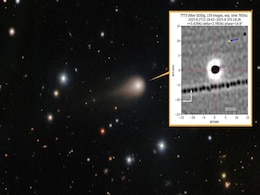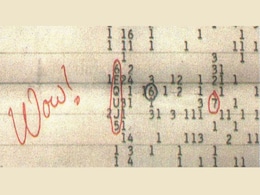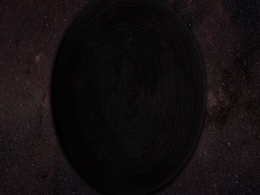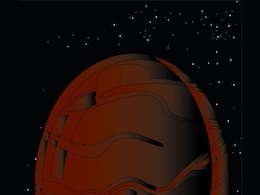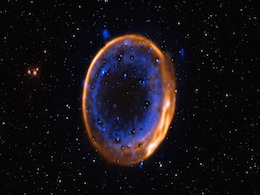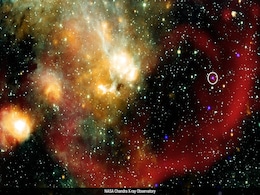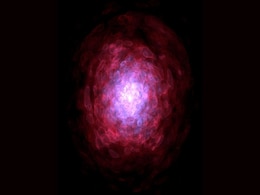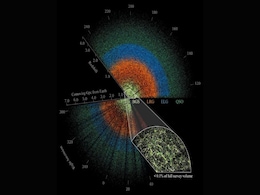Nature Astronomy
- All
- News
-

NASA’s Nancy Grace Roman Space Telescope Surpassing Expectations Even Before Launch, Reveals Research
- Tuesday November 25, 2025
- Written by Gadgets 360 Staff
NASA’s upcoming Roman Space Telescope is expected to measure seismic waves in over 300,000 red giant stars, far greater than early predictions. These signals will help scientists better understand exoplanet systems and the Milky Way’s ancient core. Researchers say Roman’s natural survey design enables this breakthrough even before the telesco...
-
 www.gadgets360.com
www.gadgets360.com
-

Interstellar Comet 3I/ATLAS Photographed Beside Distant Galaxy in Rare Cosmic Shot
- Wednesday November 19, 2025
- Written by Gadgets 360 Staff
A new image of interstellar comet 3I/ATLAS captures its glowing tails and a distant barred spiral galaxy, creating a dramatic cosmic overlap. Astronomers say the comet’s unusual features remain natural despite online speculation. With its closest Earth approach in December, researchers are preparing for sharper spacecraft images expected to revea...
-
 www.gadgets360.com
www.gadgets360.com
-

Planets Could Create Their Own Water While Forming, Expanding Possibilities for Habitable Worlds
- Tuesday November 11, 2025
- Written by Gadgets 360 Staff
Lab experiments show planets can generate water during formation, not just via comets. This suggests habitable conditions may be widespread in the galaxy, expanding possibilities for life-friendly exoplanets.
-
 www.gadgets360.com
www.gadgets360.com
-

Scientists May Have Finally Solved the Sun’s Mysteriously Hot Atmosphere Puzzle
- Thursday October 30, 2025
- Written by Gadgets 360 Staff
Scientists using the Daniel K. Inouye Solar Telescope have detected Alfvén waves in the Sun’s corona, potentially solving the long-standing mystery of its extreme heat and helping refine models of solar and stellar energy transfer.
-
 www.gadgets360.com
www.gadgets360.com
-

New Images of Interstellar Object 3I/ATLAS Show a Giant Jet Shooting Toward the Sun
- Sunday October 26, 2025
- Written by Gadgets 360 Staff
New telescope images show interstellar comet 3I/ATLAS ejecting a giant jet of gas and dust toward the Sun. Scientists say the phenomenon confirms its natural cometary behaviour, offering clues about how such ancient interstellar visitors react to solar heat.
-
 www.gadgets360.com
www.gadgets360.com
-

8 Must-Visit Dark Sky Destinations For Astronomy Lovers
- Sunday August 31, 2025
- Travel | Written by Vaishali Kapila, Edited by Neha Grover
Stargazing has captivated humans for centuries, and while city life can make it hard to experience, there are still some incredible spots around the world where the night sky is as breathtaking as it's been for millennia.
-
 www.ndtv.com/travel
www.ndtv.com/travel
-

New Analysis of 1977 Wow! Signal Reveals Stronger Cosmic Mystery
- Wednesday August 27, 2025
- Written by Gadgets 360 Staff
The famous 1977 “Wow!” signal — a mysterious radio burst detected by Ohio’s Big Ear telescope — has been reanalyzed using modern computing techniques. Researchers digitized old telescope records, finding the signal was about four times stronger than first thought, peaking at 250 Janskys. The recalculations also refined its frequency and s...
-
 www.gadgets360.com
www.gadgets360.com
-

Scientists Say Dark Matter Could Turn Failed Stars Into ‘Dark Dwarfs’
- Friday July 11, 2025
- Written by Gadgets 360 Staff
Astronomers suggest that brown dwarfs—dim, failed stars—could transform into “dark dwarfs” by capturing dark matter in their cores. When dark matter particles annihilate, they release heat, potentially lighting up these stars. Physicist Jeremy Sakstein and researchers like Jillian Paulin and Rebecca Leane support this idea, which could help...
-
 www.gadgets360.com
www.gadgets360.com
-

Dark Dwarfs: New Star-Like Objects May Reveal Nature of Dark Matter
- Wednesday July 9, 2025
- Written by Gadgets 360 Staff
Scientists have proposed a new class of stellar objects called “dark dwarfs,” sub-stellar bodies that may glow faintly from the energy released by annihilating dark matter particles. Found near the galaxy’s core, these objects could hold crucial clues about the elusive nature of dark matter. Powered not by fusion but by WIMP-like particles, d...
-
 www.gadgets360.com
www.gadgets360.com
-

Astronomers Capture First-Ever Image of a Dead Star That Exploded Twice in Rare Supernova Event
- Saturday July 5, 2025
- Written by Gadgets 360 Staff
Astronomers have captured the first-ever image of a white dwarf star undergoing a rare double-detonation supernova. Using the Very Large Telescope, the team revealed that such explosions can occur without a star reaching the Chandrasekhar limit. The findings, published in Nature Astronomy, could reshape existing theories about stellar death and imp...
-
 www.gadgets360.com
www.gadgets360.com
-

Fast Radio Bursts Reveal Universe’s Missing Matter Hidden in Cosmic Intergalactic Fog
- Thursday June 19, 2025
- Written by Gadgets 360 Staff
Astronomers have uncovered the universe’s missing baryonic matter using rapid radio bursts. The study, published in Nature Astronomy, shows that most ordinary matter lies between galaxies, hidden in faint intergalactic clouds. This breakthrough highlights FRBs as powerful tools to probe cosmic structures, paving the way for discoveries in large-s...
-
 www.gadgets360.com
www.gadgets360.com
-

Astronomers Baffled By Mysterious Object Emitting X-Rays And Radio Waves In Milky Way
- Friday May 30, 2025
- Science | Edited by Nikhil Pandey
The object, designated ASKAP J1832-0911, is located 15,000 light-years away and its nature is currently unknown, though it could be a highly magnetized dead star or something entirely new.
-
 www.ndtv.com
www.ndtv.com
-

New Study Sets Stronger Mass Limit on Ultralight Bosonic Dark Matter
- Monday May 19, 2025
- Written by Gadgets 360 Staff
A groundbreaking study has set a new lower bound on the mass of ultralight bosonic dark matter particles—2.2 × 10⁻²¹ eV. Using stellar motion data from the dwarf galaxy Leo II and advanced computational models, the team ruled out lighter masses that cannot form observed structures. This challenges the popular fuzzy dark matter theory and pav...
-
 www.gadgets360.com
www.gadgets360.com
-

New Research Suggests Dark Energy Is Evolving, Challenging Cosmology Models
- Wednesday March 26, 2025
- Written by Gadgets 360 Staff
New research from the DESI project suggests that dark energy, once thought to be a constant force, may actually be changing over time. This challenges long-held cosmological models that assume a stable influence of dark energy on the universe’s expansion. By mapping 15 million galaxies, DESI’s data raises new questions about cosmic evolution. S...
-
 www.gadgets360.com
www.gadgets360.com
-

Scientists Discover Hidden Clues to the Dark Universe in 3D Galaxy Maps
- Thursday January 30, 2025
- Written by Gadgets 360 Staff
A breakthrough study has revealed new insights into the "dark universe," which consists of dark matter and dark energy. By using a novel technique called field-level inference (FLI), scientists have discovered previously hidden details in 3D galaxy maps. This method preserves the three-dimensional nature of the data, unlike traditional compression ...
-
 www.gadgets360.com
www.gadgets360.com
-

NASA’s Nancy Grace Roman Space Telescope Surpassing Expectations Even Before Launch, Reveals Research
- Tuesday November 25, 2025
- Written by Gadgets 360 Staff
NASA’s upcoming Roman Space Telescope is expected to measure seismic waves in over 300,000 red giant stars, far greater than early predictions. These signals will help scientists better understand exoplanet systems and the Milky Way’s ancient core. Researchers say Roman’s natural survey design enables this breakthrough even before the telesco...
-
 www.gadgets360.com
www.gadgets360.com
-

Interstellar Comet 3I/ATLAS Photographed Beside Distant Galaxy in Rare Cosmic Shot
- Wednesday November 19, 2025
- Written by Gadgets 360 Staff
A new image of interstellar comet 3I/ATLAS captures its glowing tails and a distant barred spiral galaxy, creating a dramatic cosmic overlap. Astronomers say the comet’s unusual features remain natural despite online speculation. With its closest Earth approach in December, researchers are preparing for sharper spacecraft images expected to revea...
-
 www.gadgets360.com
www.gadgets360.com
-

Planets Could Create Their Own Water While Forming, Expanding Possibilities for Habitable Worlds
- Tuesday November 11, 2025
- Written by Gadgets 360 Staff
Lab experiments show planets can generate water during formation, not just via comets. This suggests habitable conditions may be widespread in the galaxy, expanding possibilities for life-friendly exoplanets.
-
 www.gadgets360.com
www.gadgets360.com
-

Scientists May Have Finally Solved the Sun’s Mysteriously Hot Atmosphere Puzzle
- Thursday October 30, 2025
- Written by Gadgets 360 Staff
Scientists using the Daniel K. Inouye Solar Telescope have detected Alfvén waves in the Sun’s corona, potentially solving the long-standing mystery of its extreme heat and helping refine models of solar and stellar energy transfer.
-
 www.gadgets360.com
www.gadgets360.com
-

New Images of Interstellar Object 3I/ATLAS Show a Giant Jet Shooting Toward the Sun
- Sunday October 26, 2025
- Written by Gadgets 360 Staff
New telescope images show interstellar comet 3I/ATLAS ejecting a giant jet of gas and dust toward the Sun. Scientists say the phenomenon confirms its natural cometary behaviour, offering clues about how such ancient interstellar visitors react to solar heat.
-
 www.gadgets360.com
www.gadgets360.com
-

8 Must-Visit Dark Sky Destinations For Astronomy Lovers
- Sunday August 31, 2025
- Travel | Written by Vaishali Kapila, Edited by Neha Grover
Stargazing has captivated humans for centuries, and while city life can make it hard to experience, there are still some incredible spots around the world where the night sky is as breathtaking as it's been for millennia.
-
 www.ndtv.com/travel
www.ndtv.com/travel
-

New Analysis of 1977 Wow! Signal Reveals Stronger Cosmic Mystery
- Wednesday August 27, 2025
- Written by Gadgets 360 Staff
The famous 1977 “Wow!” signal — a mysterious radio burst detected by Ohio’s Big Ear telescope — has been reanalyzed using modern computing techniques. Researchers digitized old telescope records, finding the signal was about four times stronger than first thought, peaking at 250 Janskys. The recalculations also refined its frequency and s...
-
 www.gadgets360.com
www.gadgets360.com
-

Scientists Say Dark Matter Could Turn Failed Stars Into ‘Dark Dwarfs’
- Friday July 11, 2025
- Written by Gadgets 360 Staff
Astronomers suggest that brown dwarfs—dim, failed stars—could transform into “dark dwarfs” by capturing dark matter in their cores. When dark matter particles annihilate, they release heat, potentially lighting up these stars. Physicist Jeremy Sakstein and researchers like Jillian Paulin and Rebecca Leane support this idea, which could help...
-
 www.gadgets360.com
www.gadgets360.com
-

Dark Dwarfs: New Star-Like Objects May Reveal Nature of Dark Matter
- Wednesday July 9, 2025
- Written by Gadgets 360 Staff
Scientists have proposed a new class of stellar objects called “dark dwarfs,” sub-stellar bodies that may glow faintly from the energy released by annihilating dark matter particles. Found near the galaxy’s core, these objects could hold crucial clues about the elusive nature of dark matter. Powered not by fusion but by WIMP-like particles, d...
-
 www.gadgets360.com
www.gadgets360.com
-

Astronomers Capture First-Ever Image of a Dead Star That Exploded Twice in Rare Supernova Event
- Saturday July 5, 2025
- Written by Gadgets 360 Staff
Astronomers have captured the first-ever image of a white dwarf star undergoing a rare double-detonation supernova. Using the Very Large Telescope, the team revealed that such explosions can occur without a star reaching the Chandrasekhar limit. The findings, published in Nature Astronomy, could reshape existing theories about stellar death and imp...
-
 www.gadgets360.com
www.gadgets360.com
-

Fast Radio Bursts Reveal Universe’s Missing Matter Hidden in Cosmic Intergalactic Fog
- Thursday June 19, 2025
- Written by Gadgets 360 Staff
Astronomers have uncovered the universe’s missing baryonic matter using rapid radio bursts. The study, published in Nature Astronomy, shows that most ordinary matter lies between galaxies, hidden in faint intergalactic clouds. This breakthrough highlights FRBs as powerful tools to probe cosmic structures, paving the way for discoveries in large-s...
-
 www.gadgets360.com
www.gadgets360.com
-

Astronomers Baffled By Mysterious Object Emitting X-Rays And Radio Waves In Milky Way
- Friday May 30, 2025
- Science | Edited by Nikhil Pandey
The object, designated ASKAP J1832-0911, is located 15,000 light-years away and its nature is currently unknown, though it could be a highly magnetized dead star or something entirely new.
-
 www.ndtv.com
www.ndtv.com
-

New Study Sets Stronger Mass Limit on Ultralight Bosonic Dark Matter
- Monday May 19, 2025
- Written by Gadgets 360 Staff
A groundbreaking study has set a new lower bound on the mass of ultralight bosonic dark matter particles—2.2 × 10⁻²¹ eV. Using stellar motion data from the dwarf galaxy Leo II and advanced computational models, the team ruled out lighter masses that cannot form observed structures. This challenges the popular fuzzy dark matter theory and pav...
-
 www.gadgets360.com
www.gadgets360.com
-

New Research Suggests Dark Energy Is Evolving, Challenging Cosmology Models
- Wednesday March 26, 2025
- Written by Gadgets 360 Staff
New research from the DESI project suggests that dark energy, once thought to be a constant force, may actually be changing over time. This challenges long-held cosmological models that assume a stable influence of dark energy on the universe’s expansion. By mapping 15 million galaxies, DESI’s data raises new questions about cosmic evolution. S...
-
 www.gadgets360.com
www.gadgets360.com
-

Scientists Discover Hidden Clues to the Dark Universe in 3D Galaxy Maps
- Thursday January 30, 2025
- Written by Gadgets 360 Staff
A breakthrough study has revealed new insights into the "dark universe," which consists of dark matter and dark energy. By using a novel technique called field-level inference (FLI), scientists have discovered previously hidden details in 3D galaxy maps. This method preserves the three-dimensional nature of the data, unlike traditional compression ...
-
 www.gadgets360.com
www.gadgets360.com





